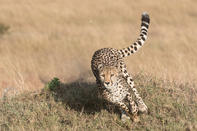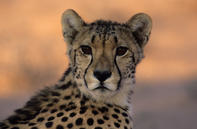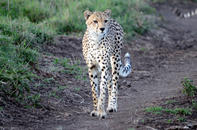Nimble and Agile

Cheetah have long legs, long, flexible spines and wasp-like waist that in combination affect the long strides necessary to run quickly. The chest of the cheetah is deep set to accommodate its large lungs and heart, the internal powerhouse of the sprinter.
The tail is long and acts as a rudder to counterbalance the cheetah when it has to change direction quickly.
Breathing Adaptations

The head is small and streamlined with only small ears. The teeth are smaller than other similar sized predators as these make the skull heavy. The reduced dentition also makes room for bigger nasal cavities to improve oxygen intake while in full sprint and to facilitate breathing when suffocating captured prey.
Cheetah also have aerodynamic nostrils to maximize the flow of air over them while running.
Better Traction

Although it is commonly thought that cheetah can’t ‘retract’ their claws at all, they do in fact have semi-retractable claws but these are unsheathed and so appear to be permanently protruding. This is an adaptation to assist with traction during chases.
Pads on the underside of the feet are hard and often ridged which also assists with traction and improves their braking ability.
By Megan Emmett